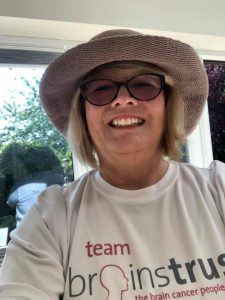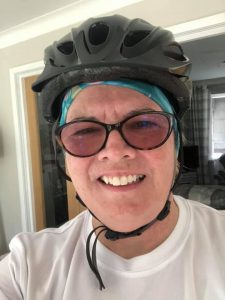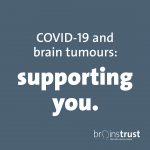Week two of Margaret’s Run, Row, Ride: LOCKDOWN EDITION diary.
Feeling fatigued is familiar territory to people with a brain tumour, so the lack of energy at the start to Margaret’s week is not surprising. Margaret completed a course of stereotactic radiotherapy in April this year! Still, read on to see her overcome a busy and challenging week, and enjoy another pearl of wisdom from Margaret in Day 14.
Day Eight
One of my challenges this time round has been my energy levels. I never seem to known from one day to the next how I will feel. However the one thing I do know is that I always feel better once I get out the door and into the fresh air.
A cool start to the week and a gentle walk/jog was in order. So important to listen to your body when fatigue decides to visit!
Thinking of everyone who could do with an energy boost on this moody Monday!
Love to all
Margaret x
Day Nine
Another slow day for me today. Just happy to have got out there this morning and to have achieved another mile or two. I was happy to get back indoors, grab a hot chocolate and curl up under a blanket!
If I’m on my own I always keep to the north side of the canal. Never far from the houses should I find myself in trouble. How lovely would it be to live here with a view of the water and wave to the walkers.
I’m missing the sunshine! Hopefully Tuesday was a positive day for everyone!
Love to all
Margaret x
Day Ten

Back in the game again! Fatigue didn’t come knocking at my door today. WINNER!!!
Managed to get my miles in under cover in the shopping centre. Flat walking and social distancing easily achieved. Have you ever seen such an empty retail space. Really eerie!
The centre is exactly half a mile from one end to the other. We did a food shop in M&S , put shopping in the car and then power walked the centre twice!!
It takes all sorts, but it was raining!
Love to all on a wet and windy Wednesday!
Margaret x
Day Eleven
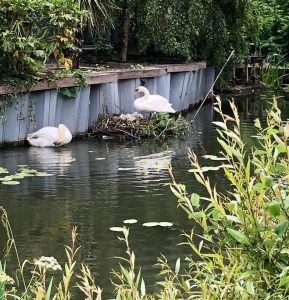
Busy, busy day today. I help care for my mum and dad who are both in their nineties. They moved close to us in April last year. I have devised a route to their house which is exactly half a mile. However, as I do this every day it feels like cheating myself if I count that as part of the challenge. Today, for one reason or another, I was backwards and forwards yo-yo. Please let those 15k steps count!
On one of the trips, I included my beautiful loop along both sides of the canal, checking on the swans and cygnets, marveling at the peace and tranquility of the canal-side walk and enjoying having the place to myself. I was pleased to have dodged the showers, managed to sidestep the puddles and arrived at my parents with a clear head, bags of energy, a smile on my face and plenty of patientce!
I ended the afternoon with a walk to Willen Lake with my wonderful dad.
A challenging day on my challenge but I came out on top!
Fresh air, the beauty of nature and some deep breaths can help so many challenging situations.
Thankful that this Thursday is over. If Thursday has been a challenge for you too I’m sending much love and a giant virtual hug.
Hope the picture lift your spirits.
Margaret x
Day Twelve
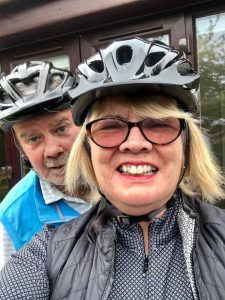
What a fantastic ride today!
We managed to miss the rain, call in to see mum and dad, have a coffee at our local cafe and spend some time looking at and marveling at the beautiful swans and cygnets!
Suddenly today my energy levels felt replenished after a weary few days and I wanted to seize the moment. After only three rides my balance is better, my legs feel stronger and my stamina has improved along with my confidence. I am starting to really enjoy getting out on my bike. Why have I not done this before?
Nothing I do is without a bit of drama. My bike 🚲 is old and changing gear can cause me problems. I freewheel as I change gear as I feel the gears stick. Bob took my bike for a test ride whilst I had my breather on the bridge. With his knees nearly hitting the handlebars he rode down the slope, round the block and back up to me. His verdict “operator error” – ignore the creaking and just keep pedalling as you change gear!!
Definitely a fabulous Friday!!
Much love and strength to you all.
Margaret x
Day Fourteen
Today I reached the half-way point in my challenge. Where has the time gone?
Today was a planned cycling day. To be honest my heart was not in it when I woke up this morning. However commitment made, I dragged myself out of bed, got myself sorted and off we went. I still haven’t been out on my bike on my own, I feel safer if Bob is with me.
Getting ready can be a challenge in itself. I take a back-pack with water, a snack, anti-seizure meds, money, phone, sunscreen, tissues… I like to be prepared, not forgetting the puncture repair kit. Fortunately I’ve not needed the latter yet.
Inevitably I leave something upstairs so run up and down a couple of times before we set off. Is it worth the effort I ask myself? YES is the resounding answer to that question!
Friends and family have been very generous in their sponsorship and having been on the receiving end of support from brainstrust the least I can do is get on my bike and pedal so that others can benefit from that same support.
It was a beautiful sunny morning and our original plan was to just ride around Willen Lake. It was incredibly busy so following my leader we turned off into uncharted territory for me. The network of redways in MK are fantastic, no need to cycle on the road at all, however you need to go down into an underpass at a roundabout and UP the other side. At times uphill can get the better of me but I only had to get off and walk once.
I am so happy that my cycling has improved so much in only a couple of weeks. Pushing myself out of my comfort zone on the bike has really helped my confidence in other areas of my life as well.
What once seemed impossible now appears to be achievable.
Success is making small changes that build into something bigger. Eventually you look back and realise how far you have come. Believe in yourself and be the best version of yourself on any given day.
It was a successful Sunday for me. I hope whatever you did today you did yourself proud.
Much love
Margaret x
Margaret’s taking part in Run, Row, Ride: LOCKDOWN EDITION – tackling 30 miles of running, rowing or riding in 30 days. Fancy the challenge? Set up your JustGiving page to get started.

